

Software - OpenVMS Hobbyist Program. Welcome to the Process Software OpenVMS Hobbyist Program!
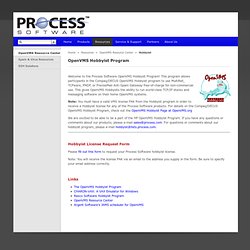
This program allows participants in the Compaq/DECUS OpenVMS Hobbyist program to use MultiNet, TCPware, PMDF, or PreciseMail Anti-Spam Gateway free-of-charge for non-commercial use. This gives OpenVMS Hobbyists the ability to run world-class TCP/IP stacks and messaging software on their home OpenVMS systems. T E X T F I L E S D O T C O M. SIMH Tips: VAX CPU idle loop detection. Emulators (simulators) are always active, barring foreknowledge of or recognition of the guest operating system idle activity or a way for the guest idle processing to inform the emulator to throttle back; you're emulating all of the processing for the guest operating system, including the idle loop within the guest operating system.
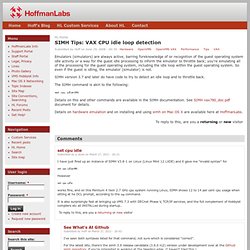
So even if the guest is idling, the emulator (simulator) is not. SIMH version 3.7 and later do have code to try to detect an idle loop and to throttle back. The SIMH command is akin to the following: set cpu idle=VMS Details on this and other commands are available in the SIMH documentation. Details on hardware emulation and on installing and using simh on Mac OS X are available here at HoffmanLabs.
OpenVMS systems documentation. The Advanced Server makes account management easy for administrators and network access easy for users, while ensuring network security.
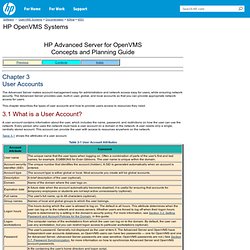
The Advanced Server provides user, built-in user, global, and local accounts so that you can provide appropriate network access for users. This chapter describes the types of user accounts and how to provide users access to resources they need. A user account contains information about the user, which includes the name, password, and restrictions on how the user can use the network. Every person who uses the network must have a user account on a domain in the network.
A user needs only a single, centrally stored account. Table 3-1 shows the attributes of a user account. For each user account, several conditions are either true or false, as shown in Table 3-2. You also can specify whether users are forced to disconnect from the domain's servers when their logon hours expire. 3.4.1 Administrator Account 3.4.1.1 Logging On as System Administrator. Clustering OpenVMS on SIMH. After following the article published earlier, you ended up with two OpenVMS 7.3 systems running on SIMH VAX emulator instances.
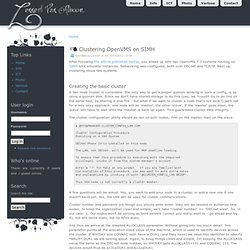
Networking was configured, both over DECnet and TCP/IP. Next up: clustering those two systems. Creating the basic cluster A two-node cluster is vulnerable: the only way to get a proper quorum working in such a config, is by using a quorum disk. Since we don't have shared storage to do this (yes, we *could* try to do this on the same host, by sharing a disk-file - but what if we want to cluster a node that's not local?) Welcome to EmuVM! VAX/VMS on Linux using SIMH. Phillip Wherry psw-at-wherry-dot-com Revision 1.5 22 January 2004 Copyright 2003-4 Phillip Wherry.
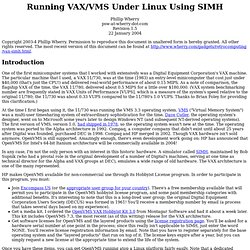
Permission to reproduce this document in unaltered form is hereby granted. All other rights reserved. The most recent version of this document can be found at Introduction One of the first minicomputer systems that I worked with extensively was a Digital Equipment Corporation's VAX machine. At the time I first began using it, the 11/730 was running the VMS 3.3 operating system. In any case, I'm not the only person with an interest in this historic hardware. HP makes OpenVMS available for non-commercial use through its Hobbyist License program. Join Encompass US (or the appropriate user group for your country). Once you have these items, you can get OpenVMS running atop a Linux platform fairly easily. But First, a Disclaimer, a Plea for Help, and a Few Acknowledgements... I've been successful in making these procedures work in my environment.
Raspberry Pi emulates VAX computers, in a cluster (Gadget Master) The power of the Pi… Check out this post on the Design Spark blog about a pair of Raspberry Pi computers emulating VAX computers (MicroVAX 3900 hardware), which can then be configured to form a VMScluster….

The Gadget Master behind this, Andrew Back, says the project was just for fun, but the more serious purpose was to “show how the Raspberry Pi can be combined with open source software such as SimH for use in computer conservation, and to provide museums etc. with the basis of a low cost demonstrator for classic computer architectures”. The power of the Pi… Check out this post on the Design Spark blog about a pair of Raspberry Pi computers emulating VAX computers (MicroVAX 3900 hardware), which can then be configured to form a VMScluster… He had previously emulated a formidable IBM mainframe, by the way – the IBM 4381! He also points out that OpenVMS is still running many a critical mission workload today. Andrew Back writes: Read the full post – there are loads of pics >> Related posts. OpenVMS beginner's FAQ. VMS -> UNIX Commands.